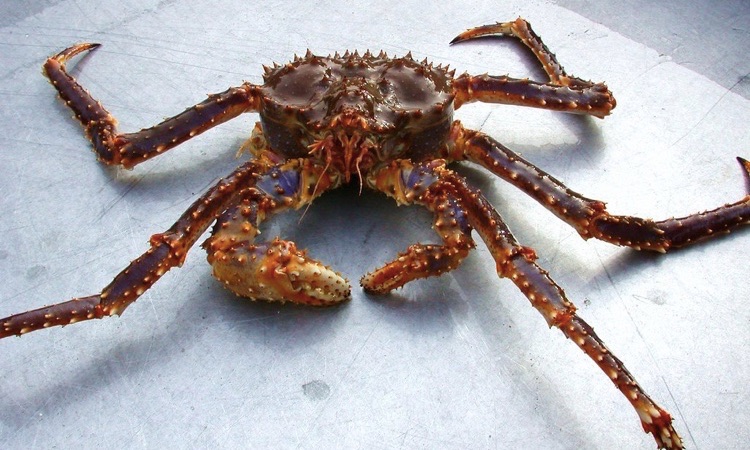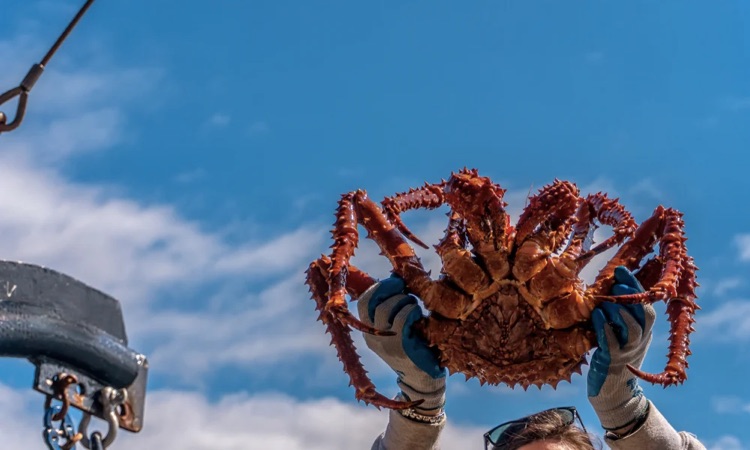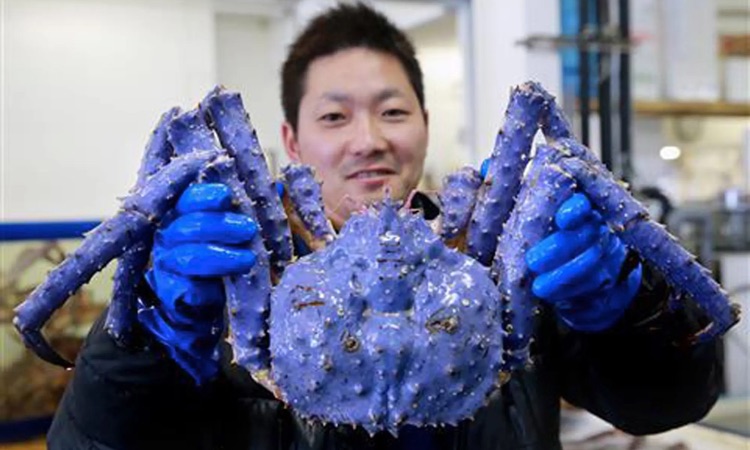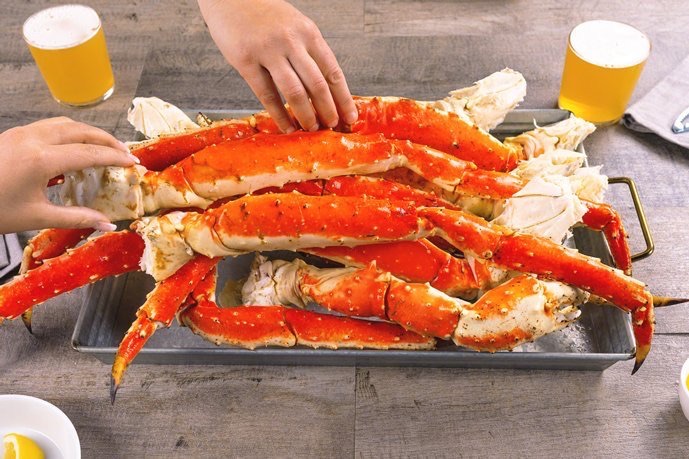The blue king crab is not only the largest of its kind but one of the biggest crustaceans too! It was a popular catch by commercial fishers, however due to decreasing numbers it’s no longer fished directly.
This species inhabits soft bottom habitats in and around areas such as The Bering Sea. Along with true crabs, prawns, and lobsters; all members of this group have ten legs – making them decopods! Read on to learn more.

Blue King Crab: Quick Facts
- It’s the most sought after crab species by fisherman
- Every year, king crabs undertake a remarkable journey, trekking up to an astonishing 100 miles in order to migrate.
- Through the course of its growth and development, the king crab sheds off its calcium-heavy shell to make way for new ones.
- Species far and wide regard king crabs as merciless adversaries.
- As soon as they hatch, the embryos are forced to survive on their own. Emerging as larvae that feed off of plankton for multiple months until they eventually settle at the bottom of the ocean.
Appearance
Male blue king crabs can reach an astonishing weight of up to 18 pounds, making them one of the biggest crustaceans known.
Compared to their red king crab cousins, blue kings are smaller in stature but no less impressive! The Pribilof Island species is particularly majestic – possessing a fan-shaped “tail” tucked beneath its hard outer shell.
The blue king crab has an eye-catching royal blue hue dappled across its brown exoskeleton. As a decapod, this majestic crustacean is gifted with ten legs and hard armor from the carapace or shell which provides protection from potential predators.
To accommodate for growth, the crab must molt off its old shell while revealing a larger one underneath to increase in size. Since their shells cannot expand like our own skin does!
At the start, a fresh shell begins to appear underneath. Afterward, the current outer covering ruptures open and as it progresses with its development. It becomes more delicate, making the blue king crab exposed to predators like crabs, fish, sea otters and octopus.
The majestic blue king crab is adorned with five sets of legs; two that contain its imposing pincers, and the remaining three used for ‘walking’.
Notably, the right claw is often larger than its counterpart—a distinct feature to be admired. Additionally, one set of legs are found tucked underneath their backside – smaller in size but no less important!
During mating season, the females will use their legs to groom and clean their embryos. While the males utilize theirs to transfer sperm to the female.

Habitat
Blue king crabs are scattered in multiple frigid water habitats, from Japan’s Hokkaido to the Sea of Okhotsk and from Siberia all the way down to the Bering straits. In particular, they thrive near St. Matthew Island and Pribilof Islands off of Alaska’s coast in the Bering Sea.
Blue king crab, native to North America, live in the Diomede Islands, Point Hope, outer Kotzebue Sound, King Island and Norton Sound. They also inhabit fjord-like bays of the southeastern region of Alaska’s Gulf.
Lifespan
Blue king crabs typically live between 3-4 years. They reach maturity at a 18 months. Approximately fifty percent of blue king crab reach maturity upon reaching 5 inches. However, female St. Matthew Island and Diomede crabs achieve this milestone at a smaller size – just 3 inches!
Reproduction
In order to ascertain the age of a blue king crab, scientists usually observe its hard parts of shell. But as these tend to fall away during molting, it can be difficult to determine their average lifespan. Though estimations suggest that they have life expectancies ranging from 20-30 years.
Blue king crabs reproduce only every two years. During spawn year, the female crabs shed their shells and then mate, releasing up to 150,000 eggs. Afterward, from January until February these females are in charge of carrying the developing embryos for approximately 14 months before they hatch.
The hatching of their eggs ranges from February to May, contingent on the water’s temperature. In Pribilof Islands, female crabs usually discharge their larvae in mid-April while other areas have a tendency to start off earlier during that same period.
It takes a female blue king crab roughly 29 days to release her progeny, who then embark on four stages of development that span around 10 days each. Temperature plays an essential role in this process .
The lower it is, the more sluggish and drawn out their growth will be. Conversely, warmer temperatures speed up their progress immensely. During the initial stage alone, larvae need to locate food within only 60 hours!
At the fifth stage, larvae enter a state of suspended animation and begin to morph into mini crab-like creatures. They do not feed during this period.
After swimming with the help of their abdomens as a makeshift ‘tail’, these larvae search for optimum places to settle. This triggers them to molt into the first juvenile stage. This entire process usually takes 2 and a half up to 4 months, culminating in July – September when they metamorphose.

Food
Notorious for being a gluttonous omnivore, the blue king crab will happily consume nearly any dead plant or animal material in its vicinity. Depending on the water depth and species of these crabs, their diet may vary significantly.
King crabs are known for their appetite of a variety, with clams, worms, sea stars and urchins being just some of the items on its menu. Crustaceans such as lobsters, shrimp and other crabs also make up part of this carnivore’s diet. These crabs also eat dead fish and algae.
In most cases king crabs will consume barnacles, sand dollars or brittle stars too. All ensuring that these majestic creatures have every taste preference catered for!
Threats & Predators
People are still one of the biggest risks to blue king crabs, even though fishermen have not targeted them for over two decades. The species population has been decreasing like clockwork since its closure in 1988 due to low numbers and it has officially been deemed as “overfished” from 2002 onwards.
Before that, these brilliant crustaceans had generated a million-dollar industry for commercial fishers with their popularity rising sharply. Hence why we must protect them now more than ever!
Despite a lack of population growth since 1995, the blue king crab can be legally sourced from fisheries that target other species. As opposed to trawl or similar fishing methods which could potentially damage its habitat, this delectable crustacean is instead caught through traps.
Owing to the absence of commercial fishing, this ecosystem is secure and stable. The Diomede blue king crab population may not have been harvested commercially in the past. However, it has consistently been utilized among a subsistence fishery within the Native Village of Diomede that consists of 170 people.
The cold water habitats of blue king crabs are scattered across the globe. This is possibly due to rising temperatures that followed the most recent glacial era. This insulated distribution could be a consequence of temperature shock on them or an indication of how far warm waters have spread and given rise to warm-water predators.
The blue king crab is threatened by a range of predators. This includes other crabs, halibut and Pacific cod fish, sea otters and octopuses.

Conservation Status
The blue king crab population is unfortunately too low to support a commercial fishery. Most of the species concentrated around St. Matthew Island and the Pribilof Islands.
The NOAA has placed this particular type of blue king crab on its list of overfished species. This has prompted calls for conservation action. However, greater study and constant monitoring are necessary before any measures can be implemented successfully.


